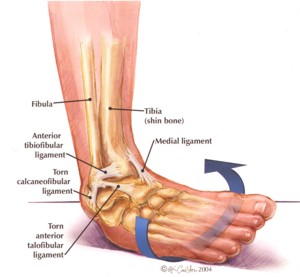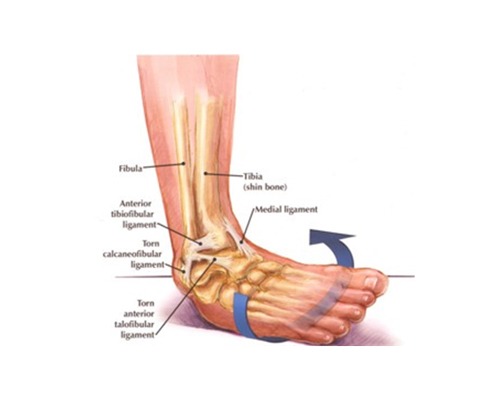A “sprain” relates to an injury of the ligaments. The most common injured ligament in the ankle is the anterior talofibular ligament (ATFL). This runs along the outside of the ankle and is injured when you “roll” the ankle.

How does an ankle sprain happen?
Ankle sprains happen when the foot is awkwardly placed either on an unstable surface or upon landing. The most common sprain occurs when you roll or twist the ankle. If you have a history of “rolling” the ankle then you are more likely to have the injury happen again. This is because when you damage the ligament you also damage its proprioceptors. These are specialised cells within the ligament which ensure the foot is placed in the correct position when walking or exercising. If they are damaged they do not complete this function correctly and you are more likely to place the foot incorrectly. The research shows us if you have sprained the ankle you have a 40-70% higher chance of reinjuring the ankle.
What are the different type of ankle sprains?
With all sprains there are 3 separate grades of injury.
Grade 1 (Mild) – The ligament has been overstretched but still intact with no damage to the ligament itself. You may feel some localised soreness around the ankle.
Grade 2 (Moderate) – The ligament has been overstretched with a partial tear in the ligament itself. You will experience moderate levels of pain, limping & some localised bruising/swelling. You may also experience some instability in the ankle.
Grade 3 (Severe) – The ligament has been overstretched and completely ruptures. You will often hear a pop or snap sound at the time of injury. You will experience; high levels of pain, severe swelling/bruising & inability to put pressure on the ankle.
What treatments are available for Ankle Sprains & What can I do?
The treatment available for ankle sprains varies on the grade of the ligament damage.
Grade 1 Treatment:
- Strap the ankle to give it extra support whilst the healing process takes place
- Complete rest until all pain has disappeared
- Ice around the localised areas of pain
- Elevation of the ankle when at home
- Wear supportive footwear whilst walking during the day
- Gentle massage around the area of pain
Grade 2 Treatment:
- The points above apply to Grade 2 ligament tears however further treatment & rehab is necessary
- Acupuncture around the site of pain to help reduce inflammation
- Massage along the site of pain
- Shockwave therapy to help ensure the correct development of scar tissue
- Laser therapy to reduce pain/inflammation
- Specific targeted strengthening and proprioceptive training (Speak to your sports injury specialist about this). This helps to reduce the risk of re-injury
Grade 3 Treatment:
- If you think you have a complete rupture go see your doctor or A&E immediately
- Normally the treatments involve surgery or a cast put around the ankle.
- Avoid all pressure on the ankle and do not exercise
We understand that sometimes it can be difficult to diagnose an injury without any medical training. Therefore if you are unsure or just want some piece of mind please book an appointment to see an injury specialist. They will be able to correctly diagnose the problem and inform you on the appropriate steps moving forwards.



